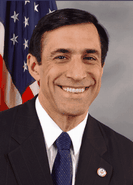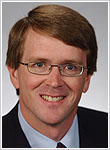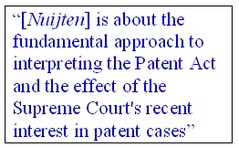Patent Reform is in the Air
To continue reading, become a Patently-O member. Already a member? Simply log in to access the full post.
Prosecution Data
To continue reading, become a Patently-O member. Already a member? Simply log in to access the full post.
Cargill v. Canbra: Extensive Prosecution Increases Likelihood of Inequitable Conduct
To continue reading, become a Patently-O member. Already a member? Simply log in to access the full post.
Love Means Business at the PTO
To continue reading, become a Patently-O member. Already a member? Simply log in to access the full post.
District Court Patent Pilot moves Forward

On January 12, the House passed Issa’s patent court pilot program:
H. R. 34: To establish a pilot program in certain United States district courts to encourage enhancement of expertise in patent cases among district judges.
To continue reading, become a Patently-O member. Already a member? Simply log in to access the full post.
Gene Patenting; or Patenting Life
To continue reading, become a Patently-O member. Already a member? Simply log in to access the full post.
Shield vs. Sword: CAFC Finds Inequitable Conduct But Not Antitrust Fraud
To continue reading, become a Patently-O member. Already a member? Simply log in to access the full post.
USPTO Allowance Rate:
To continue reading, become a Patently-O member. Already a member? Simply log in to access the full post.
Claim Transitions: "Comprising The Steps Of"
To continue reading, become a Patently-O member. Already a member? Simply log in to access the full post.
Signals Per Se; Nuijten; Textualism; and Floodgates
To continue reading, become a Patently-O member. Already a member? Simply log in to access the full post.
Deposition Do’s and Don’ts: The Patent Interference Bar Is Warned
To continue reading, become a Patently-O member. Already a member? Simply log in to access the full post.
Peer-to-Patent Expected To Launch in April 2007
To continue reading, become a Patently-O member. Already a member? Simply log in to access the full post.
Patentable Subject Matter: Professor Hricik Discusses Duffy’s Textualism
To continue reading, become a Patently-O member. Already a member? Simply log in to access the full post.
Microsoft v. AT&T: Transnational patent Law
Microsoft v. AT&T (Supreme Court 2007).
Section 271(f) of the Patent Act expands the territorial scope of US patent protection by creating liability for exporting one or more “components” of a patented invention so that the whole invention may be practiced abroad. The statute is divided into parts one and two dealing with inducement and contributory activity respectively.
The case at hand involves Microsoft’s infringement of AT&T’s speech coding technology patent. Microsoft has conceded that its software (once installed on a computer) infringes the patent in the US. However, Microsoft has fought against paying patent royalties for sale of the same software abroad. Microsoft’s argument, spelled out in its brief, is two-fold: (1) Software cannot be a ‘component’ as required by the statute because software code is intangible; and (2) Software copies made abroad cannot be considered ‘supplied’ from the US as required by the statute because no physical particle that Microsoft exported actually became part of the finished product. I have previously labeled these arguments as the tangibility requirement and the molecular conservation requirement. [Link]
Now, AT&T and its supporters has filed their briefs that explain why 271(f) should encompass foreign copies of software shipped from the US. [Petitioner and Gov’t briefs are discussed here]
AT&T’s Brief on the Merits:
Tangibility: AT&T attacks the tangibility requirement head-on, arguing that there is no such requirement.
[The software] is plainly a component of [the patented] device, just as a unique collection of intangible words is a component of any book bearing the title Moby-Dick, even though those words, too, must be combined with ink and paper before the book can be read.
Of course AT&T is correct — the statute does not spell-out any tangibility requirement, and Microsoft’s statutory argument is, at best implicit. AT&T’s arguments are supported by business practice as well. Software and hardware are developed and sold separately, and each side can easily be though of as providing components of the whole.
Molecular Conservation Requirement: AT&T takes a different view of the statutory requirement that the components be “supplied” from the US. In AT&T’s story, “supplied” means satisfying a need or furnishing. Using a but-for analysis, AT&T makes clear that without Microsoft’s shipment of the code abroad, it would not have ended-up in the foreign computers.
Here, the Windows object code is present in the foreign made computers only because Microsoft “provided” or “furnished”—in a word, supplied—it from the United States, via golden master disk or electronic transmission.
As it stands, the AT&T brief is well written and convincing on its own — the major problem being that it leads with a petty argument for dismissal.
Philips Corporation also filed a brief in support of AT&T. Philips makes several arguments, two of which I discuss here:
- In today’s market, software and hardware companies do compete head-to-head. A finding that software export is noninfringing would be at the expense of electronics companies because hardware exports would continue to be considered infringing. Thus, awarding the win to Microsoft here may free the software industry, but will even further damage the hardware export industry.
- In many ways, this case is about the size of damages. Microsoft hopes that copies made abroad will not be seen as infringing because those copies were not literally shipped from the US. Philips points out under the rules of consequential damage calculations, Microsoft would owe damages for sales of all copies even if 271(f) only covered the initial master disk shipment.
WARF, California, and RCTech filed a joint brief in support of AT&T. These holders of strong bio-related patents see the potential that this case could narrow the scope of their protection. WARF points-out how Microsoft comes to the table with unclean hands:
When it suits its interests, even Microsoft acknowledges that the number of units it supplies is not limited by the number of golden masters it sends abroad. In Microsoft Corp. v. Comm’r of Internal Revenue, Microsoft argued that it was entitled to tax deductions . . . for all foreign sales of software replicated from Microsoft’s golden master abroad, claiming that such copies were "export property" under the statute. The Ninth Circuit . . . agreed with Microsoft that all copies created from the golden master were export property, thereby providing Microsoft with another $31 million in claimed deductions for 1990 and 1991.
BAYHDOLE25.inc is an educational NGO that supports, as you might guess, the Bayh Dole act (at its 25th anniversary). In a brief supporting AT&T, BD25 argues for the protection of intangible assets — especially assets that are replicable and intended to be replicated. These include software code, cell lines, patented seeds, DNA, etc. Replicable assets are important and should be protectable.
Documents:
- On the Merits
- In Support of Microsoft
- Petitioner: Microsoft Brief;
- Amicus: US Government;
- Amicus: Law Professors (Lemley & Duffy);
- Amicus: Amazon;
- Amicus: SIIA (Industry Org.);
- Amicus: SFLC (Moglen & Ravicher);
- Amicus: Shell Oil (Method Claims);
- Amicus: Intel;
- Amicus: AIPLA;
- Amicus: Eli Lilly;
- Amicus FICPI;
- Amicus Autodesk
- Amicus BSA (Industry will be destroyed if AT&T wins);
- Amicus Yahoo!.
- Respondent: AT&T;
- Amicus: BayhDole25.inc;
- Amicus: US Philips;
- Amicus: UC WARF RCTech.
- Amicus: Professor Edward Lee.
- Petitioner: Microsoft Reply Brief.
- Petitioner: Microsoft Petition
- Petitioner: Microsoft Petition Appendix
- Respondent: AT&T Opposition
- Petitioner: Microsoft Reply in Support
- Respondent: AT&T Supplemental Brief
- Petitioner: Microsoft Supplemental Brief
- Amicus: Software and Information Industry Association in Support of Microsoft
- Amicus: Government in Support of Microsoft
Important recent 271(f) cases:
- NTP v. Research in Motion, (271(f) “component” would rarely if ever apply to method claims).
-
AT&T v. Microsoft, 414 F.3d 1366 (Fed. Cir. 2005) (271(f) “component” applies to method claims and software being sold abroad);
-
Union Carbide v. Shell Oil (Fed. Cir. 2005) (271(f) “component” applies to method claims).
-
Eolas v. Microsoft, 399 F.3d 1325 (Fed. Cir. 2005) (271(f) “component” applies to method claims and software);
-
Pellegrini v. Analog Devices, 375 F.3d 1113 (Fed. Cir. 2004) (271(f) “component” does not cover export of plans/instructions of patented item to be manufactured abroad);
-
Bayer v. Housey Pharms, 340 F.3d 1367 (Fed. Cir. 2003) (271(g) “component” does not apply to importation of ‘intangible information’).
Earlier Discussion of this case
- https://patentlyo.com/patent/2006/12/microsoft_v_att.html
- I will be discussing this and other extraterritorial issues at Duke University Law School on February 23, 2007. Link.
Text of 35 USC 271(f)
(1) Whoever without authority supplies or causes to be supplied in or from the United States all or a substantial portion of the components of a patented invention, where such components are uncombined in whole or in part, in such manner as to actively induce the combination of such components outside of the United States in a manner that would infringe the patent if such combination occurred within the United States, shall be liable as an infringer.
(2) Whoever without authority supplies or causes to be supplied in or from the United States any component of a patented invention that is especially made or especially adapted for use in the invention and not a staple article or commodity of commerce suitable for substantial noninfringing use, where such component is uncombined in whole or in part, knowing that such component is so made or adapted and intending that such component will be combined outside of the United States in a manner that would infringe the patent if such combination occurred within the United States, shall be liable as an infringer.
To continue reading, become a Patently-O member. Already a member? Simply log in to access the full post.
Divided Congress Finds Common Ground in Patent Reform
To continue reading, become a Patently-O member. Already a member? Simply log in to access the full post.
In re Nuijten: Patentable Subject Matter, Textualism and the Supreme Court

[PDF Version of this Post] In re Nuijten, which is being argued to the Federal Circuit today, presents the important issue of whether a new type of artificially constructed signal may be patented. The Patent and Trademark Office opposes patentability on the grounds that, as a matter of textual interpretation, signals do not fall within any one of the four categories of patentable subject matter - "process, machine, manufacture, or composition of matter" - identified in section 101 of the Patent Act. PTO Br. at 12 (quoting 35 U.S.C. § 101). Though Nuijten raises important issues concerning the scope of patentable subject matter under U.S. law (and that's reason enough for most patent practitioners and scholars to care about its outcome), the case is also about much more. It is about the fundamental approach to interpreting the Patent Act and the effect of the Supreme Court's recent interest in patent cases. To appreciate those larger issues, we must begin with a basic understanding of the facts at issue.

To continue reading, become a Patently-O member. Already a member? Simply log in to access the full post.
One for Slashdot
To continue reading, become a Patently-O member. Already a member? Simply log in to access the full post.
Voda v. Cordis: Plaintiff May Not Assert Foreign Patents in US Courts

Jan Voda, an Oklahoma medical doctor sued Cordis for infringement of his patent on an interventional cardiology catheter. Voda had obtained patents both in the US and abroad. Not wanting to waste time and money on multiple suits, Voda asked the US court to also determine his claims of foreign infringement based on his patents in the UK, Canada, France, and Germany. The US court agreed, but Cordis appealed — arguing that the district court improperly extended its jurisdiction.
In a 2–1 decision, the Federal Circuit (Gajarsa) has held that the district court cannot exercise supplemental jurisdiction over Voda’s foreign patent claims. Judge Newman dissents.
Supplemental Jurisdiction: Federal courts are designed to hear federal law. But, every day they exercise their power to decide issues that arise under the law of other jurisdictions. Usually the other jurisdictions are US states and municipalities. But, the courts are also regular interpreters of non-US law as well. Non-Federal questions arise based on either “diversity jurisdiction” or “supplemental jurisdiction.” Supplemental jurisdiction is spelled-out in 28 USC 1367:
[after establishing] original jurisdiction, the district courts shall have supplemental jurisdiction over all other claims that are so related to claims in the action within such original jurisdiction that they form part of the same case or controversy under Article III of the United States Constitution.
In many cases, supplemental jurisdiction has been found to extend to include foreign law claims. However, the “so related” portion of the statute has been interpreted to require that the supplemental claims arise from a “common nucleus of operative fact” and that the claims would “ordinarily be expected to [all be tried] in one judicial proceeding.” Here, the CAFC did not determine whether supplemental jurisdiction exists because it found that the district court had abused its discretion (see below).
Discretion and Comity: Even if jurisdiction exists, its exercise is “within the discretion of the district court.” The CAFC found that the district court abused its discretion by ignoring the Paris Convention, TRIPS and concepts of comity.
Like the Paris Convention, nothing in the PCT or the Agreement on TRIPS contemplates or allows one jurisdiction to adjudicate patents of another. . . . Based on the international treaties that the United States has joined and ratified as the "supreme law of the land," a district court’s exercise of supplemental jurisdiction could undermine the obligations of the United States under such treaties, which therefore constitute an exceptional circumstance to decline jurisdiction under § 1367(c)(4). Accordingly, we must scrutinize such an exercise with caution. . . .
The territorial limits of the rights granted by patents are similar to those conferred by land grants. A patent right is limited by the metes and bounds of the jurisdictional territory that granted the right to exclude. Therefore, a patent right to exclude only arises from the legal right granted and recognized by the sovereign within whose territory the right is located. It would be incongruent to allow the sovereign power of one to be infringed or limited by another sovereign’s extension of its jurisdiction. Therefore, while our Patent Act declares that "patents shall have the attributes of personal property," 35 U.S.C. § 261, and not real property, the local action doctrine constitutes an informative doctrine counseling us that exercising supplemental jurisdiction over Voda’s foreign patent claims could prejudice the rights of the foreign governments.
. . . Because the purpose underlying comity is not furthered and potentially hindered in this case, adjudication of Voda’s foreign patent infringement claims should be left to the sovereigns that create the property rights in the first instance.
Judicial Economy: While the CAFC agreed with voda that “consolidated multinational patent adjudication could be more efficient,” the court worried that it would also cause additional problems of confusion and difficulty understanding and enforcing foreign actions.
Changing Circumstances: Finally, the court left the door open if “circumstances change.”
In addition, we emphasize that because the exercise of supplemental jurisdiction under § 1367(c) is an area of discretion, the district courts should examine these reasons along with others that are relevant in every case, especially if circumstances change, such as if the United States were to enter into a new international patent treaty or if events during litigation alter a district court’s conclusions regarding comity, judicial economy, convenience, or fairness.
Vacated and Remanded
To continue reading, become a Patently-O member. Already a member? Simply log in to access the full post.
Patent Law Tidbits
To continue reading, become a Patently-O member. Already a member? Simply log in to access the full post.